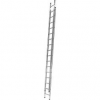oldMohawk
gone but not forgotten
A forum pic of what looks like the same bus in a post below ...
1904 outside the Council House.

1904 outside the Council House.

 birminghamhistory.co.uk
birminghamhistory.co.uk
Those very long timber ladders, the last I saw of a similar length were in Cambridge in the 1980's, had very stout strings (sides) which were far more sturdy than the extension ladders of recent times, hence their good rigidity. The fire services used, in the past, timber ladders with trussing to maintain stability.


Viewed from Colmore Row. The original length of this street is reflected in the phrase "with a face as long as Livery Street." It was much longer before it was cut through by the Queensway. I read somewhere that City Road is Birmingham's longest street.

c bryants used a lot of pole ladders when they re built the hockley brook,and sewer in aston in 1960s. as mortun said they sure flexed........It's called a pole ladder because its made from a pole of timber cut down highways then holes drilled for the rungs. Quite heavy, so mainly used on scaffolds, where you have an uninterrupted clime to the top. Great if your hod carrying, but pole ladders are a bit bendy.
There was one at spaghetti junction at Salford Bridge when they were building it that stretched from just underneath the M5 motorway platform to the ground by the River tame. Possibly the longest one I have ever used. When you got about halfway it was really bouncing in the middle, just like the cake walk.
 a modern aluminium 10m ladder
a modern aluminium 10m ladderThe comparison is remarkable. The old, presumably ready for demolition, but having lots of traffic of differing types and lots of people waking about. The new having the a quite severe and uninteresting appearance with mainly cars and few people (may have been a Sunday) Neither much to write home about, but the old photo has interest as there are a good variety of car makes (they all look much the same today) and there is I believe one of the rebuilt Midland Red GHA Daimlers. There are three newer style KEEP LEFT signs and one of the older bollard type. Noticeably there is no yellow marking lines.
The load on that lorry (a Fordson?) looks a little unsafe, but of course these were still in the times of "the joys of motoring" which, as far as I can see, have long gone.
I get the impression the industrial scene was different here than elsewhere. ( italicized to avoid politics).The difference I see is that in picture one there are Fords, Vauxhalls, Austins, Morrises, Jaguars, and even an Armstrong Siddeley.
Picture two is full of German, French, Japanese and Korean cars.
Whatever happened to the great boost the British car industry was going to get from joining the Common Market?
That is pretty ugly!
While in Colmore Row Keith Berry looked down Livery Street. He often added comments to his photos as in the quote under the image. I had heard the one about Livery Street but not sure about his comment about City Road ...
View attachment 138256
The modern view and it looks good.
View attachment 138257
I continue to be amazed at how many great Then & Now photos are on the Forum! Thank you all...…….Changes being made to Five Ways in the 1960s
View attachment 138288
A computer generated aerial view of how it looks now.
View attachment 138289
I think you are right on point!Central Brum seems to be just traffic and skyscrapers these days.
Maurice
Driving through the city is scarier than LA and there is something I thought I would never say, but trying to get from Lichfield Road (If it is still called that) to Hagley Road recently was horrific, mainly due to trying to read the plethora of signs and watch as you are being overtaken and undertaken.Central Brum seems to be just traffic and skyscrapers these days.
Maurice



